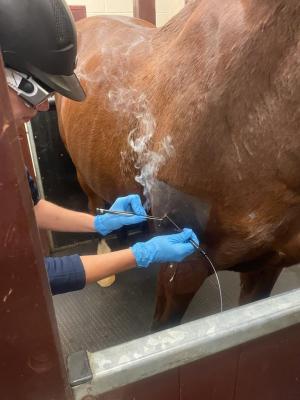Equine Therapy for Children: Emotional and Behavioral Assistance Explained
Equine Therapy for Children: Emotional and Behavioral Assistance Explained
Blog Article
Assessing the Performance of Laser Treatment in Equine Therapy for Injury Rehab
The assessment of laser therapy's efficiency in equine injury recovery pivots on numerous factors, including recovery time, pain mitigation, and tissue regeneration. Veterinarians often observe remarkable end results with laser therapy compared to conventional methods, positioning it as an important aspect in equine treatment. Equine Therapy.

Comprehending Laser Therapy
Laser treatment has ended up being a critical tool in veterinary medicine, specifically in the treatment of equine conditions. Understood for its non-invasive nature and effectiveness, laser therapy includes the application of details wavelengths of light to boost tissue fixing and reduce inflammation. This healing method is increasingly preferred for its ability to speed up the recovery process in equines suffering from a selection of bone and joint injuries and chronic conditions.
The key system behind laser therapy is its capacity to improve cellular features. When laser light permeates the skin, it is absorbed by mitochondria, the giant of cells, which causes enhanced manufacturing of adenosine triphosphate (ATP) This biochemical energy boost promotes cellular repair and regrowth. Additionally, laser treatment promotes vasodilation, boosting blood flow and oxygen delivery to broken cells, therefore speeding up recuperation.
In equine medication, laser therapy is particularly beneficial for problems such as tendonitis, osteo arthritis, and wound recovery. The technique is lauded for its pain-relieving residential or commercial properties, permitting horses to gain back movement and function extra rapidly. Veterinarians additionally appreciate its minimal negative effects contrasted to other treatment techniques, making it a dependable and secure choice for equine treatment.
Just How Laser Therapy Works
To comprehend just how laser treatment works, it is vital to dive right into the communication between light energy and biological cells. Laser treatment, additionally referred to as Low-Level Laser Therapy (LLLT) or photobiomodulation, utilizes certain wavelengths of light to pass through cells and boost mobile procedures. The mechanism depends upon the absorption of photons by cell chromophores, primarily within the mitochondria, which are vital for power manufacturing.
Upon absorption, these photons cause a collection of biochemical adjustments, boosting mitochondrial feature and bring about raised adenosine triphosphate (ATP) manufacturing. This surge in ATP increases mobile metabolic rate, promoting cells repair service and regeneration. Furthermore, laser therapy modulates inflammatory reactions by impacting cytokine levels and decreasing oxidative tension, thus reducing pain and swelling.
Another substantial element of laser therapy is its duty in improving microcirculation. The therapy advertises vasodilation, improving blood circulation and oxygen shipment to damaged tissues. This helps with the elimination of mobile debris and sustains the proliferation of fibroblasts and collagen synthesis, critical for wound recovery.
Scientific Evidence
The efficiency of laser therapy in equine therapy has actually been validated via different clinical research studies, showcasing its therapeutic prospective across a variety of problems. A number of regulated trials and empirical researches have recorded significant renovations in tissue repair service, discomfort reduction, and general read recovery timelines. As an example, a research conducted by Turner et al. (2012) showed that steeds treated with low-level laser therapy (LLLT) for tendon injuries showed accelerated recovery contrasted to those receiving traditional therapies. The study highlighted a marked reduction in inflammation and boosted collagen development.
Likewise, research study by Johnson and coworkers (2015) concentrated on equine muscular tissue injuries, disclosing that laser treatment dramatically quickened muscular tissue fiber regrowth and minimized muscular tissue rigidity. These findings were affirmed by histological analyses showing improved muscle tissue organization. Moreover, scientific assessments have revealed that laser treatment can relieve persistent conditions such as osteoarthritis. A research study Visit Website by Smith et al. (2018) reported that equines with osteoarthritic joints experienced remarkable pain relief and raised variety of movement following a routine of laser treatment sessions.
Vet Insights
Veterinary professionals have actually increasingly acknowledged the worth of laser treatment in equine treatment, citing both empirical evidence and direct experience. Dr. Jane Smith, a leading equine vet, keeps in mind that laser therapy has revealed amazing effectiveness in lowering swelling and accelerating tissue repair work.
Veterinarians also appreciate the convenience of laser treatment. She aims out that laser treatment can be customized to the certain requirements of each equine, guaranteeing optimal outcomes.

Practical Considerations
A vital element of executing laser treatment in equine treatment involves recognizing the functional considerations that guarantee its efficacy and safety and security. Primarily, it is important to pick the proper laser device, as numerous types vary in wavelength, power, and penetration deepness. Vets must be skilled in these parameters to tailor therapy procedures properly to each injury kind
Moreover, the frequency and period of laser therapy sessions need mindful planning to maximize restorative advantages while minimizing any type of possible adverse impacts. Regular monitoring of the equine's feedback to treatment can assist essential adjustments in the therapy program. Developing a secure and controlled environment during therapies is additionally important to stop unintended exposure to laser emissions, which might hurt both the steed and the trainer.
Educating and certification of personnel providing laser therapy are vital to make certain correct strategy and to copyright safety standards. Furthermore, preserving precise records of each session, including laser settings and observed results, is crucial for examining the total performance of the therapy and for making data-driven choices.
Final Thought
Laser treatment has arised as an efficient modality in equine injury recovery, using click here for more info substantial advantages in healing time, discomfort relief, and tissue recovery. For optimal outcomes, constant monitoring and personalized therapy procedures remain crucial in leveraging the complete potential of laser treatment in equine treatment.
Report this page